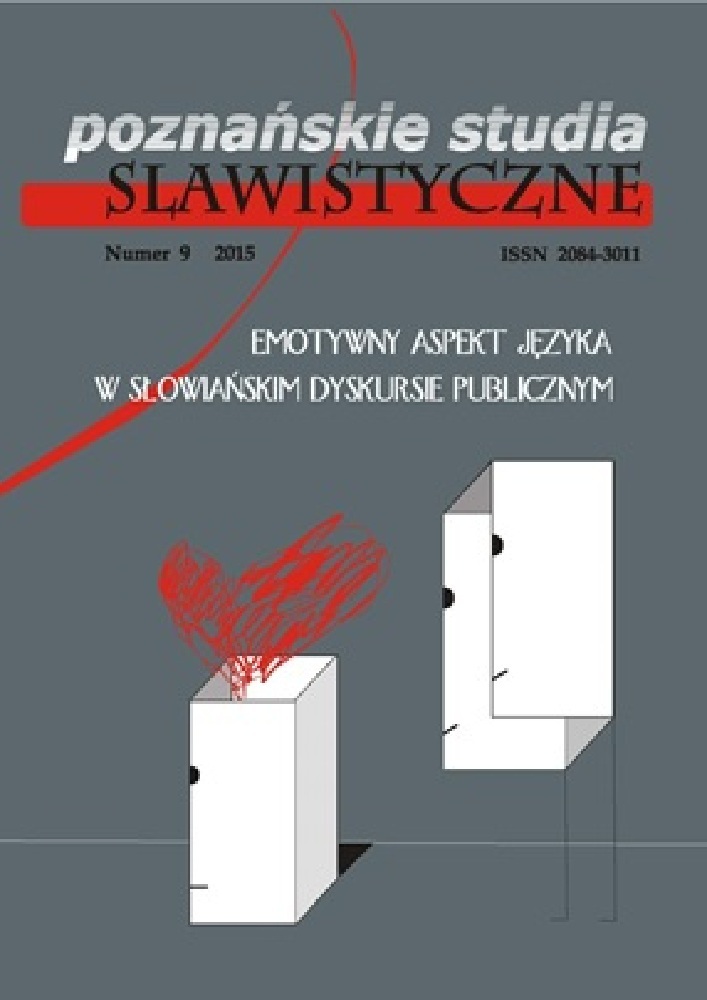Abstract
In this paper we (re-)examine the role of deliberate metaphors in the public discourse. Based on an analysis of metaphorical comments to the articles reporting on a dispute between the Croatian Prime Minister and Minister of Finance, we argue that in addition to a number of established discursive functions, metaphor may perform a therapeutic function aiding commenters in working through their emotions. Our analyses of the course that comments take shows that they are not structured according to a usual turn-taking logic, but rather on the basis of the coherence of the emotions shared by the commenters. Moreover, the tripartite internal structure of the comments (identifying the critical event, running the blend, possibly offering a solution to the critical event) is aimed at symbolically delegitimizing politicians, putting the author in charge of the experience, thus enabling him/her to work through it. Theoretically, such a view suggests that on the discourse level it is not necessarily metaphor that is used as the structuring device, but that emotion can structure metaphor.
References
Cameron L., 2003, Metaphor in educational discourse, London.
Cavalcanti M.C., Bizon A.C., 2008, En Route through Metaphors: Chatrooms as Safe Places to Deal with Difficulties, in: Confronting Metaphor in Use: An Applied Linguistic Approach, ed. M.S. Zanotto, L. Cameron, M.C. Cavalcanti, Amsterdam––Philadelphia, p. 243–65.
Charteris-Black J., 2011, Politicians and rhetoric: the persuasive power of metaphor, Houndmills–Basingstoke–Hampshire–New York. http://dx.doi.org/10.1057/9780230319899
Delfino M., Manca S., 2007, The expression of social presence through the use of figurative language in a web-based learning environment, “Computers in Human Behavior” no. 5, p. 2190–2211, DOI:10.1016/j.chb.2006.03.001. http://dx.doi.org/10.1016/j.chb.2006.03.001
De Landtsheer C., 2009, Collecting Political Meaning from the Count of Metaphor, in: Metaphor and Discourse, ed. A. Musolff, J. Zinken, Basingstoke, p. 59–78.
http://dx.doi.org/10.1057/9780230594647_5
Fauconnier G., Turner M., 2003, The way we think: conceptual blending and the mind’s hidden complexities, New York.
Frank R.M., 2008, Introduction:Sociocultural situatedness, in: Body, Language, and Mind, vol. 2, Sociocultural situatedness, ed. R.M. Frank, R. Dirven, T. Ziemke, J. Zlatev, E. Bernárdez, Berlin–New York, p. 1–18.
Geeraerts D., Gevaert C., and Speelman, D., 2011, How anger rose: Hypothesis testing in diachronic semantics, in: Current Methods in Historical Semantics, ed. K. Allan, J.A. Robinson, Berlin–Boston, p. 109–131.
http://dx.doi.org/10.1515/9783110252903.109
Griffiths P., Scarantino A., 2009, Emotions in the Wild: The Situated Perspective on Emotion, in: The Cambridge Handbook of Situated Cognition, ed. P. Robbins, M. Aydede, New York, p. 473–453.
Hampel R., 2006, Rethinking task design for the digital age: A framework for language teaching and learning in a synchronous online environment, “ReCALL” no. 1, p. 105–121, DOI:10.1017/S0958344006000711.
http://dx.doi.org/10.1017/S0958344006000711
Hart C., 2008, Critical discourse analysis and metaphor: toward a theoretical framework, “Critical Discourse Studies” no. 2, p. 91–106, DOI:10.1080/17405900801990058.
Hart C., 2010, Critical Discourse Analysis and Cognitive Science: New Perspectives on Immigration Policies, Basingstoke.
http://dx.doi.org/10.1080/17405900801990058
Henrich N., Holmes B., 2013, Web news readers’ comments: Towards developing a methodology for using on–line comments in social inquiry, “Journal of Media and Communication Studies” no. 1, p. 1–4, DOI:10.5897/JMCS11.103.
Johnson M., 1993, Moral Imagination: Implications of Cognitive Science for Ethics, Chicago–London.
Kimmel M., 2010, Why we mix metaphors (and mix them well): discourse coherence, conceptual metaphor, and beyond, “Journal of Pragmatics” no. 1, p. 97–115, doi : 16/j.pragma.2009.05.017.
Koller V., 2005, Critical discourse analysis and social cognition: evidence from business media discourse, “Discourse & Society” no. 2, p. 199–224, DOI:10.1177/0957926505049621.
http://dx.doi.org/10.1177/0957926505049621
Koller V., 2013, Metaphern in der Palliativversorgung und Sterbebegleitung, “Leidfaden” no. 2, p. 13–15, DOI: 10.13109/leid.2013.2.3.13.
http://dx.doi.org/10.13109/leid.2013.2.3.13
Kövecses Z., 2000, Metaphor and emotion: language, culture, and body in human feeling, Cambridge–New York.
Kövecses Z., 2012, Emotion concepts in cultural context: the case of happiness, Dynamicity in emotion concepts, ed. P.A. Wilson, Frankfurt am Main–Berlin–Bern–Bruxelles–New York–Oxford–Warszawa-Wien, p. 159–182.
Lakoff G., Johnson M., 1980, Metaphors We Live By, Chicago–London.
Lakoff G., 1993, The contemporary theory of metaphor, in: Metaphor and Thought, ed. A. Ortony, Cambridge, p. 202–251.
http://dx.doi.org/10.1017/CBO9781139173865.013
Littlemore J., Low G., 2006, Figurative thinking and foreign language learning, Basingstoke–New York.
http://dx.doi.org/10.1057/9780230627567
Manosevitch E., Walker D.M., 2009, Reader Comments to Online Opinion Journalism: A Space of Public Deliberation, Conference paper. 10th International Symposium on Online Journalism, Austin, TX, April 2009, <https://online.journalism.utexas.edu/2009/papers/ManosevitchWalker09.pdf>, 12.02.1015.
Musolff A., 2004, Metaphor and Political Discourse. Analogical Reasoning in Debates about Europe, Basingstoke–New York.
http://dx.doi.org/10.1057/9780230504516
Robert T., Kelly V.A., 2010, Metaphor as an Instrument for Orchestrating Change In Counselor Training and the Counseling Process, “Journal of Counseling & Development” no.2, p.182–188, DOI:10.1002/j.1556–6678.2010.tb00007.x.
http://dx.doi.org/10.1002/j.1556-6678.2010.tb00007.x
Semino E., 2014, Metaphors at the end of life: results from a large study, Conference paper presented at the 8th World Research Congress of the European Association for Palliative Care (EAPC), Lleida, Spain, <http://ucrel.lancs.ac.uk/melc/EAPC2014–slides.pdf>, 12.02.2015.
Stanojević M.-M., 2013, Konceptualna metafora: temeljni pojmovi, teorijski pristupi i metode, Zagreb.
Stanojević M.-M., Ljubičić M., Tralić I., 2014, Grammatical information and conceptual metaphors: the case of anger, in: Language and Information: Proceedings from the CALS conference 2102, ed. M.-M. Stanojević, A. Peti-Satntić, Frankfurt am Main–Berlin–Bern–Bruxelles–New York–Oxford–Wien, p. 131–154.
Steen G., 2008, The paradox of metaphor: why we need a three-dimensional model of metaphor, “Metaphor and Symbol” no. 4, p. 213–241, DOI:10.1080/10926480802426753.
http://dx.doi.org/10.1080/10926480802426753
Steen G., 2014, Deliberate Metaphor Affords Conscious Metaphorical Cognition, “Cognitive Semiotics” no. 5, p.179–197.
Traugott E.C., 2008, ‘All that he endeavoured to prove was...’ On the emergence of grammatical constructions in dialogic contexts, in: Language in Flux: Dialogue Coordination, Language Variation, Change and Evolution, ed. R. Cooper, R. Kempson, London, p. 143–177.
Šarić Lj., 2014, Metafora, diskurs i društvo, in: Metafore koje istražujemo: suvremeni uvidi u konceptualnu metaforu, ed. M.-M. Stanojević, Zagreb, p. 169–202.
Verhagen A., 2005, Constructions of intersubjectivity: discourse, syntax, and cognition, Oxford.
Wilce J.M., 2009, Language and Emotion, New York. http://dx.doi.org/10.1017/CBO9780511626692
Zinken J., Hellsten I., Nerlich B., 2008, Discourse metaphors, in: Body,Language, and Mind. Volume 2: Sociocultural situatedness, ed. R.M. Frank, R. Dirven, T. Ziemke, J. Zlatev, E. Bernárdez, Berlin–New York, p. 363–387.
Zinken J., Musolff A. (ed.), 2009, Metaphor and Discourse, Basingstoke.
License

This work is licensed under a Creative Commons Attribution-NoDerivatives 4.0 International License.
